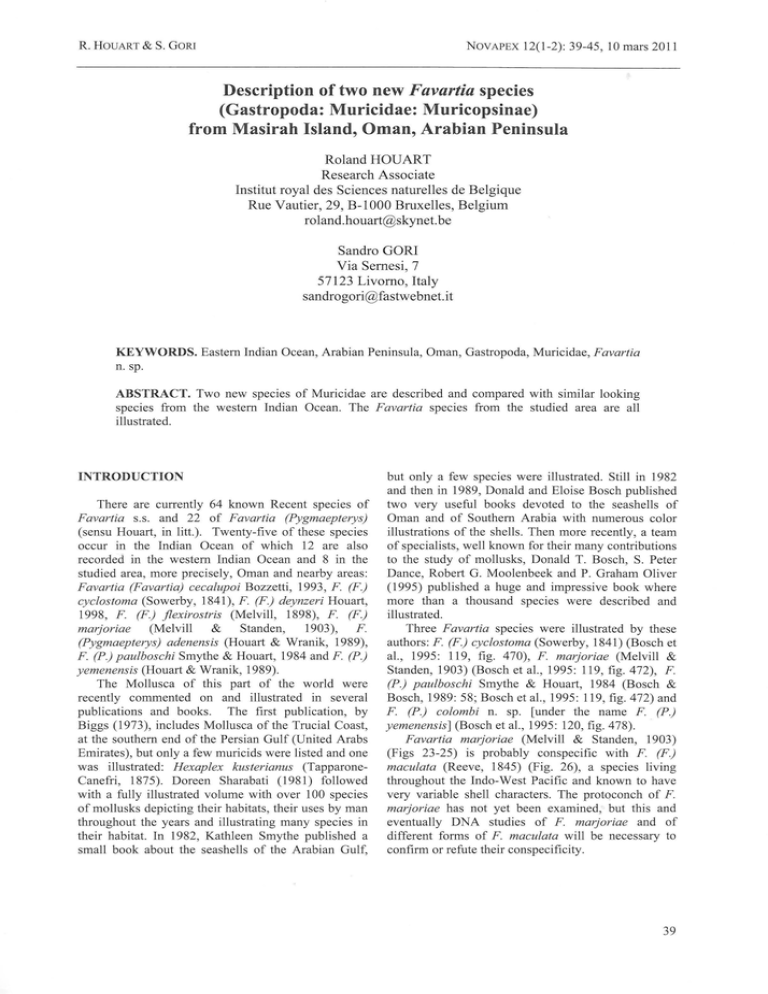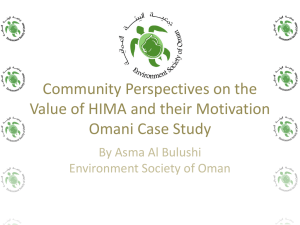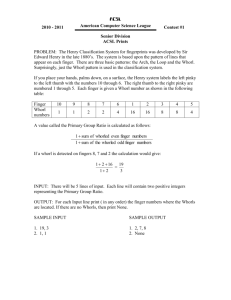Description of two new species (Gastropoda: Muricidae: Muricopsinae)
advertisement

R. HOU ART & S. GORI NOV APEX 12(1-2): 39-45, 10 mars 2011 Description of two new Favartia species (Gastropoda: Muricidae: Muricopsinae) from Masirah Island, Oman, Arabian Peninsula Roland HOUART Research Associate Institut royal des Sciences naturelles de Belgique Rue Vautier, 29, B-1000 Bruxelles, Belgium roland.houart@skynet. be Sandra GORI Via Semesi, 7 57123 Livomo, Italy sandrogori@fastwebnet.it KEYWORDS. Eastern Indian Ocean, Arabian Peninsula, Oman, Gastropoda, Muricidae, Favartia n. sp. ABSTRACT. Two new species of Muricidae are described and compared with similar looking species from the western Jndian Ocean. The Favartia species from the studied area are ail illustrated. INTRODUCTION There are currently 64 known Recent species of Favartia s.s. and 22 of Favartia (Pygmaepterys) (sensu Houart, in litt.). Twenty-five of these species occur in the Indian Ocean of which 12 are also recorded in the western Indian Ocean and 8 in the studied area, more precisely, Oman and nearby areas: Favartia (Favartia) cecalupoi Bozzetti, 1993, F. (F.) cyclostoma (Sowerby, 1841 ), F. (F.) deynzeri Houart, 1998, F. (F.) flexirostris (Melvill, 1898), F. (F.) marJorzae (Melvill & Standen, 1903), F. (Pygmaepterys) adenensis (Houart & Wranik, 1989), F. (P.) paulbaschi Smythe & Houart, 1984 and F. (P.) yemenensis (Houart & Wranik, 1989). The Mollusca of this part of the world were recently commented on and illustrated in severa! publications and books. The first publication, by Biggs (1973), includes Mollusca of the Trucial Coast, at the southern end of the Persian Gulf (United Arabs Emirates), but only a few muricids were listed and one was illustrated: Hexaplex kusterianus (TapparoneCanefri, 187 5). Doreen Sharabati (1981) followed with a full y illustrated volume with over 100 species of mollusks depicting their habitats, the ir uses by man throughout the years and illustrating many species in their habitat. In 1982, Kathleen Smythe published a small book about the seashells of the Arabian Gulf, but only a few species were illustrated. Still in 1982 and th en in 1989, Donald and Eloise Bosch pub li shed two very useful books devoted to the seashells of Oman and of Southern Arabia with numerous color illustrations of the shells. Then more recently, a team of specialists, weil known for their many contributions to the study of mollusks, Donald T. Bosch, S. Peter Dance, Robert G. Moolenbeek and P. Graham Oliver (1995) published a huge and impressive book where more than a thousand species were described and illustrated. Three Favartia species were illustrated by these authors: F. (F.) cyclostoma (Sowerby, 1841) (Bosch et al., 1995: 119, fig. 470), F. marjoriae (Melvill & Standen, 1903) (Bosch et al., 1995: 119, fig. 472), F. (P.) paulboschi Smythe & Houart, 1984 (Bosch & Bosch, 1989: 58; Bosch et al. , 1995: 119, fig . 472) and F. (P.) colombi n. sp. [un der the name F. (P.) yemenensis] (Bosch et al., 1995 : 120, fig . 478). Favartia marjoriae (Melvill & Standen, 1903) (Figs 23-25) is probably conspecific with F. (F.) maculata (Reeve, 1845) (Fig. 26), a species living throughout the Indo-West Pacifie and known to have very variable shell characters. The protoconch of F. marjoriae has not yet been examined, but this and eventually DNA studies of F. marjoriae and of different forms of F. maculata will be necessary to confirrn or refute their conspecificity. 39 R. HOUART & S. GOR! Two new Favartia species from Masirah Island Table 1. Terminology used to de scribe the spiral cords and apertural denticles (after Merle, 1999 and 2001) Terminology in parentheses: erratic feature . Primary cord P: secondar:y cord s: Infrasutural primary cord (primary cord on subsutural ram_Q)_ IP: adapical infrasutural secondéll}'_ cordJ...on subsutural ramp) adis : abapical infrasutural secondary co rd (on subsutural ram__I:)} abis: Shoulder cord Pl : Primary cords of the convex part of the teleoconch whorl P2-P6: secondary cords of the convex_Q_art of the teleoconch whorl sl-s6 : exampJe: s = secondary cordb etween Pl an d P2 ; s2 = secon dary cordb et ween P2 an d P3 , e t c. ADP: adapertural primary co rd on the siQ_honal canal MP : median primary cord on the siphonal canal ABP: abapertural primary cord on the si.2_honal canal adapertural secondary cord on the siphonal canal ads: ms: median secondary cord on the siQ_honal canal abs: abapertural secondary cord on the siphonal canal eabs: extreme abapertural secondary cord on the siQhonal canal Example: eabsl = secondary cord between EABP and EABPl APERTURE ID: Dl to D6: Abbreviations SYSTEMATICS BMNH: Natural History Museum, London, U.K. IRSNB: Institut royal des Sciences naturelles de Belgique, Bruxelles, Belgium. MNHN: Muséum national d'Histoire naturelle, Paris, France. JC: Collection of Jacques Colomb, Marseille, France. RH: Collection of Roland Houart. SG: Collection of Sando Go ri. Family MURICIDAE Rafinesque, 1815 Subfamily MURICOPSINAE Radwin & D'Attilio, 1971 Genus Favartia Jousseaume, 1880 Type species by original designation: Murex breviculus Sowerby, 1834, Recent, lndo-West Pacifie. Favartia (Favartia) colombin. sp. Figs 1, 2-6, 27 Pygmaepterys yemenensis - Bosch et al. 1995: 120, fig . 478. Type material. Oman, Masirah Island, Ras Al Ya, 20°29'42" N, 58°57'029" E, 21 rn, on coarse sand, holotype IRSNB IG 31676/ MT 2316. Paratypes: Oman, Masirah Island, Ras Al Ya, 20°29'42" N, 58°57'029" E, 21 rn, on coarse sand, 1 MNHN 23206; Sur Masirah, east of Masirah Island, 1 rn, low tide, under stones, 1 BMNH 20100521; Oman, Masirah Island, Ras Al Y a, 20°39'504" N, 58°52' 138" E, 21 rn, on sand 4 RH, 7 SG; Masirah Island, 2 rn, 1 JC, 1 RH. Figure 1. Terminology of the spiral sculpture morphology in Favartia colombin. sp. 40 Other material examined. Oman, Masirah Island, Ras Al Ya, 20°32'895" N, 58°57'420" E, 13 rn, on sand (8 SG, 2 RH); Masirah Island (3 JC); Masirah Island, 2 rn (2 JC); Sur Masirah, east of Masirah, 1 rn, low tide, under stones (15 JC); North of Muscat, Mina al Fahl, 24-30 rn, dredged, sand and mud (4 RH). R. HOUART & S. GORI Distribution. Oman, north of Muscat and Masirah Island. Description. Shell medium-sized for the genus, up to 16.5 mm in height at maturity. Height/width ratio 1.63-1.93:1. Slender, lanceolate, shoulder weakly sloping, weakly concave. Greyish-white or tan with lighter colored primary spiral cards. Aperture light brown within. Spire high with 1.6 protoconch whorls and teleoconch up to 5 weakly angular, strongly shouldered whorls. Suture impressed, partially obscured by third primary spiral cord (P3) of previous whorl. Protoconch small. Whorls with a single strong but narrow adapical keel. Terminallip thin, erect, weakly curved. Axial sculpture of teleoconch whorls consisting of prominent, narrow varices, each with short, scabrous, open spinelets decreasing in strength and length abapically, connected to each other with scabrous flange . Nine varices from first to third teleoconch whorl, decreasing to 6-8 on fourth whorl and 4 or 5 on last whorl. Spiral sculpture of high, strong, narrow, smooth primary cards and occasionally very narrow secondary cards. First and second whorls with visible P 1 and P2 or P 1-P3. Third and fourth wh oris of juvenile specimens with Pl, P2, s2, P3, P4, P5, P6, ADP and MP. Fifth whorl with Pl, (sl), P2, s2, P3, (s3), P4, P5, s5, P6, (s6), ADP, MP, ABP. Shoulder ramp smooth except for axial varices. Pl-P4 almost similar in size and strength, P4 and P5 close to each other, P5 weakly narrower, P6 narrower spiral cord, almost half the size of Pl-P4; ADP and MP broad. Primary cards more obvious on adapertural part of varices. Secondary cards very narrow, only obvious on variêes. Aperture moderately small, ovate. Columellar lip narrow, smooth, rim partially erect at abapical extremity, otherwise adherent. Anal notch shallow, broad. Outer lip weakly erect, weakly crenulated, with weak, elongate denticles within: ID, Dl or Dl split, D2 split, D3 split, D4 and D5. ID very low, Dl low, D2-D5 increasing in strength abapically. Siphonal canal short, 23-29% of total shell height, narrow, weakly dorsally recurved at tip, narrowly open, with 2 or 3 short scabrous spines originating from ADP, MP and ABP. ADP broadest. Operculum and radula unknown. Remarks. Other Favartia s.s. species occur in the western Indian Ocean, mostly along the East African coast, up to Somalia and the Red Sea. The species most similar to F. colombi n. sp. are Favartia (Favartia) cecalupoi Bozzetti, 1993, F. cyclostoma (Sowerby, 1841 ), F. nu cula (Reeve, 1845), F. peasei (Tryon, 1880), F. rosamiae D'Attilia & Myers, 1985 and F. sykesi (Preston, 1904). Favartia cecalupoi (Fig. 13) from Somalia differs in many respects i.e. the protoconch which consists of 2 smooth bulbous whorls. The shell is more rounded with a broader last teleoconch whorl, the varices are NOVAPEX 12(1-2): 39-45, 10 mars 2011 lower and the spiral cards are more numerous. F. cyclostoma is larger relative to the number of teleoconch whorls, the shell is also much broader with a rounded paucispiral protoconch of 1.5 whorls. F. nucula, F. rosamiae, F. peasei and F. sykesi differ in many respects su ch as bread th and height of the shell, axial and spiral sculpture and mainly by having different protoconch whorls, small, rounded and paucispiral in F. nucula and F. peasei, conical and multispiral in F. rosamiae (Figs 14, 32) and F. sykesi. Favartia (Pygmaepterys) paulboschi Smythe & Houart, 1984 (Figs 15-16, 28), another Favartia species from Oman differs in having a relatively narrower shell vs its height, broader and flat primary spiral cards, fewer or absence of secondary cards, narrower varices with more adapically recurved shoulder spine, and relatively shorter and broader siphonal canal. Favartia (F.) colombi was also confused with, and wrongly identified as F. (P.) yemenensis Houart & Wranik, 1989 (Figs 17-18, 29) (Houart, in litt.) which also has a keeled protoconch, and therefore was also illustrated as Pygmaepterys yemenensis in Bosch et al. (1995: 120). However, F. yemenensis differs from F. colombi n. sp. in having a more angular and broader shell with higher and narrower varices, in having a comparatively broader aperture, a longer siphonal canal and more numerous secondary spiral cards. Favartia (Pygmaepterys) adenensis (Fig. 19) also occur in this area but is very different and does not need to be compared here. Etymology. colombi: Named after Jacques Colomb (Marseille, France) who collected severa! specimens of the new species in Masirah, together with the junior au thor. Favartia (Favartia) roseotincta n.sp. Figs 7-12, 30 Type mate rial. Oman, Masirah, Ras Al Y a, 20°39'504" N, 58°52'138" E, 21 rn, on sand, holotype MNHN23205 Paratypes: 3 RH, 3 SG. Distribution. Oman, Masirah Island. Description. Shell small for the genus, up to 8.3 mm in length at maturity. Height/width ratio 1.66 - 1.86:1, biconical, narrow, weakly spinose. Shoulder strongly sloping, weakly convex. Pinkish white or light pink, occasionally with white varices and white siphonal canal. Aperture pink within, surrounded with white on columellar lip outer rim and outer apertural lip. Spire high with 1.5 protoconch whorls and teleoconch up to 5 weakly convex, angular, strongly shouldered whorls. Suture impressed. Protoconch small, elongate, whorls rounded, last whorl strongly elongate. Terminal hp eroded. 41 R. HOU ART & S. GOR! Axial sculpture of teleoconch whorls consisting of high, strong, narrow varices, each with short, broad, blunt, open primary spines. First whorl with 8 varices, second to fourth with 8 or 9 varices, last whorl with 4 varices. Varices oflast whorl broader and more distant from each other than in other whorls, with a large gap between third and fourth (apertural) varices, almost twice the distance between second and third varices. Spiral cords from first to penultimate teleoconch whorl of high, narrow, smooth primary cords. First and second whorls with visible Pl and P2, or Pl-P3, P3 partially covered with next whorl, third and fourth whorl with visible Pl-P3, P3 still partially covered by next whorl. Last whorl with IP, Pl-P5, (s5), P6, (s6), ADP, MP. IP only weakly visible on axial varices, Pl-P3 almost of same strength, P3 occasionally narrower, P4-P6 decreasing in strength abapically, P4 and P5 high, broad, P6 very small, almost obsolete, occasionally preceded by almost obsolete s5. Aperture small, ovate, columellar lip narrow, smooth, lip partially erect, adherent on shell at 30-40% of adapical extremity. Anal notch moderately broad. Outer lip erect, with weak elongate, narrow denticles within: ID (split), Dl split, D2 (split), D3, D4, D5. Siphonal canal short, narrow, strongly dorsally recurved at tip, narrowly open, with ADP and MP giving rise to short, open, blunt spines. Operculum and radula unknown . Remarks. A few species of Favartia have an elongate and narrow shell such as observed in F. roseotincta n. sp., namely F. jlexirostris (Melvill, 1898), F. guamensis Emerson & D' Attilio, 1979, F. iredalei Ponder, 1972, F. jeanae Bertsch & D'Attilia, 1980 and F. peregrina (Oiivera, 1980). Favartia jlexirostris (Figs 20, 31) which also occurs in Oman, differs from F. roseotincta n. sp. by many shell characters, namely in having a rounded, globose protoconch (Fig. 31), more rounded teleoconch whorls with a globose last whorl and a Two new Favartia species from Masirah Island rounded aperture, numerous, broad, secondary spiral cords on the whole shell, and a longer, more strongly tapered siphonal canal. Favartia guamensis differs also in many ways, namely by having a very different, conical protoconch of sinusigeral type, consisting of 3-3.5 whorls, denoting planktotrophic larval development. Its geographical distribution is therefore also much more expanded, ranging from off Mozambique (East Africa) to the Tuamotus (Central Pacifie). Other differences are numerous such as the lower and broader spire whorls, the narrower and straighter shoulder ramp, the broader and more squamous primary spiral cords, the small, rounded aperture with a characteristic narrow, deep anal notch and the single spine (ADP) on the narrower siphonal canal. Favartia iredalei (Fig. 21) from Lord Howe Island, NSW, Australia and West Sumatra also has a different protoconch of 1.5 rounded whorls. It differs also in having a less sloping and narrower shoulder ramp with IP, or adis and IP, and in having more squamous primary cords and obvious secondary cords on the convex part of the last teleoconch wh or!. Both F. jeanae and F. peregrina from the Philippines also differ in having a different larval development, denoted by their conical, multispiral protoconch of 3-3.5 whorls and a terminal lip of sinusigeral type. The shell morphology ofF. jeanae is close to F. roseotincta n.sp but besides the protoconch differences, the shell differs in having a comparatively higher spire, narrower primary spiral cords, obvious adis and IP on the shoulder ramp, and a narrower, tapered siphonal canal. Favartia peregrina differs in many ways and does not need to be compared further here. Another species from Elat (Red Sea), was named Favartia elatensis Emerson & D' Attilio, 1979 but it actually turned out to be a Murexsul species (Houart, 1994, Merle & Houart, 2003) and differs from F. roseotincta in many respects . Figures 2-22 2-6. Favartia (Favartia) colombin. sp. 2-3. Oman, Masirah Island, Ras Al Y a, 20°29' 42" N, 58°57'029" E, 21 m, holotype IRSNB IG 31676/ MT 2316, 15 .6 mm; 4-5. Oman, Masirah Island, Ras Al Y a, 20°39'504" N, 58°52'138" E, 21 rn, paratype RH, 12 mm; 6. Oman, Masirah Island, Ras Al Y a, 20°29'42" N, 58°57'029" E, 21 m, paratype MNHN 23206 7-12. Favartia (Favartia) roseotincta n. sp., Oman, Masirah, Ras Al Y a, 20°39'504" N, 58°52'138" E, 21 m. 7-8. Holotype MNHN 23205, 8.3 mm; 9-10. Paratype SG, 8.2 mm; 11-12. Paratype RH, 8.1 mm . 13. Favartia (F.) cecalupoi Bozzetti, 1993, Ras Hafun, Somalia, SG, 12.4 mm; 14. Favartia (F.) rosamiae D'Attilia & Myers, 1985, Seychelles, RH, 15.6 mm ; 15-16. Favartia (F.) paulboschi Smythe & Houart, 1984, Dhuwwah, Masirah, Oman, paratype RH, 17 mm; 17-18. Favartia (Pygmaepterys) yemenensis (Houart & Wranik, 1989); 17. Gu1fof Aden, RH, 23 mm; 18. Oman, Masirah Island, Ras Al Ya, SG, 16.7 mm; 19. Favartia (P.) adenensis (Houart & Wranik, 1989), Gulf Of. Aden, PDR Yemen, paratype RH, 15.4 mm; 20. Favartia (F.) jlexirostris (Mel vil!, 1898), Oman, N Of. Muscat, RH, 11 .3 mm; 21. Favartia (F.) iredalei Ponder, 1972, Australia, NSW, Lord Howe Island, RH, 6.1 mm; 22. F avartia (F.) jeanae Bertsch & D'Attilia, 1980, Philippines, Cebu, RH, 8.5mm. 42 R. HüUART & S. GOR! NOV APEX 12(1-2): 39-45, 10 mars 2011 43 R. HOUART & S . GORJ Favartia colombi n.sp. described above as occurring in the same area differs in being larger with a similar number of teleoconch whorls, in having a different protoconch morphology (Figs 27 vs 30) and in having more numerous secondary spiral cords. The variable spacing between penultimate and last (apertural) varix is an unusual feature observed in F. roseotincta. Such unusual cases of a distinct larger Two new Favartia species from Masirah Island gap between these two varices are seen in two other muricopsine species: Favartia rosamiae (Fig. 14) and F. varimutabilis Houart, 1991 from the Lesser Antilles and southeastem Brazil. Etymology. roseotincta (L): Named for its color which is reminiscent of a beautiful pink and white rose. Figures 23-32 23-25. Favartia (Favartia) marjoriae (Melvill & Standen, 1903) 23. Persian Gulf, Sheikh Shuaib Island, 15 fms (27 rn), syntype BMNH 1903.11.5.18.19, 27.5 mm.; 24-25. Persian Gulf, IRSNB IG 10591, 29 mm. 26. Favartia maculata (Reeve, 1845), Thailand, Phuket Island, RH, 18.7 mm. 27-32. Protoconchs (scale bars 0.5 mm) 27. Favartia (Favartia) colombi n.sp (RH); 28. Favartia (Pygmaepterys) paulboschi (RH); 29. Favartia (P.) yemenensis (SG); 30. Favartia (F.) roseotincta n. sp. (SG); 31. Favartia (F.) jlexirostris (RH); 32. Favartia (F.) rosamiae (RH). 44 R. HOUART & S. GORT ACKNOWLEDGEMENTS. We are very thankful to Jacques Colomb, Marseille, France, for the loan of his material and the gift of two specimens, to Greg Herbert, University of South Florida, Tampa, U.S .A. for his useful comments on the ms and to John Wolff, Lancaster, Pennsylvania, U.S.A., for checking the English text. REFERENCES Biggs, H. E. J. 1973. The marine Mol lusca of the Trucial coast, Persian Gulf. Bulletin of the British Museum (Natural History) , Zoology Vol. 24(8): 343-421 , 6 pis. Bosch, D. & Bosch, E. 1982. Seashells of Oman. Longman Group Ltd., England. pp. 1-206. Bosch, D. & Bosch, E. 1989. Seashells ofSouthern Arabia. Motivate Publishing, U.A.E. pp.l-95. Bosch, D.T., Dance, S.P. , Moolenbeek, R.G & Oliver, P.G. 1995. Seashells of Eastern Arabia. Ed. P. Dance, Motivate Publishing. pp. 1-296. NOV APEX 12(1-2): 39-45, 10 mars 2011 Houart, R. 1994. Illustrated catalogue of Recent species of Muricidae named sin ce 1971. Wiesbaden: 1-179. Merle, D. 1999. La radiation des Muricidae (Gastropoda : Neogastropoda) au Paléogène: approche phylogénétique et évolutive. Paris. Unpublished thesis, Muséum national d'Histoire naturelle : i-vi, 499 pp. Merle, D. 2001. The spiral cords and the internai denticles of the outer lip in the Muricidae: terminology and methodological comments. Novapex 2 (3) : 69-91 . Merle, D. & Houart, R. 2003 . Ontogenetic changes of the spiral cords as keys innovation of the muricid sculptural patterns: the example of the MuricopsisMurexsul!ineages (Gastropoda: Muricidae: Muricopsinae). CR. Palevol. 2: 547-561. Sharabati, D. 1981. Saudi Arabian seashells. Selected Red Sea and Arabian Gulf molluscs. VNU Books International, Library of Congress. pp 1-119. Smythe, K. 1982. Seashells of the Arabian Gulf. London, G. Allen & Unwin . pp. 1-123. 45




